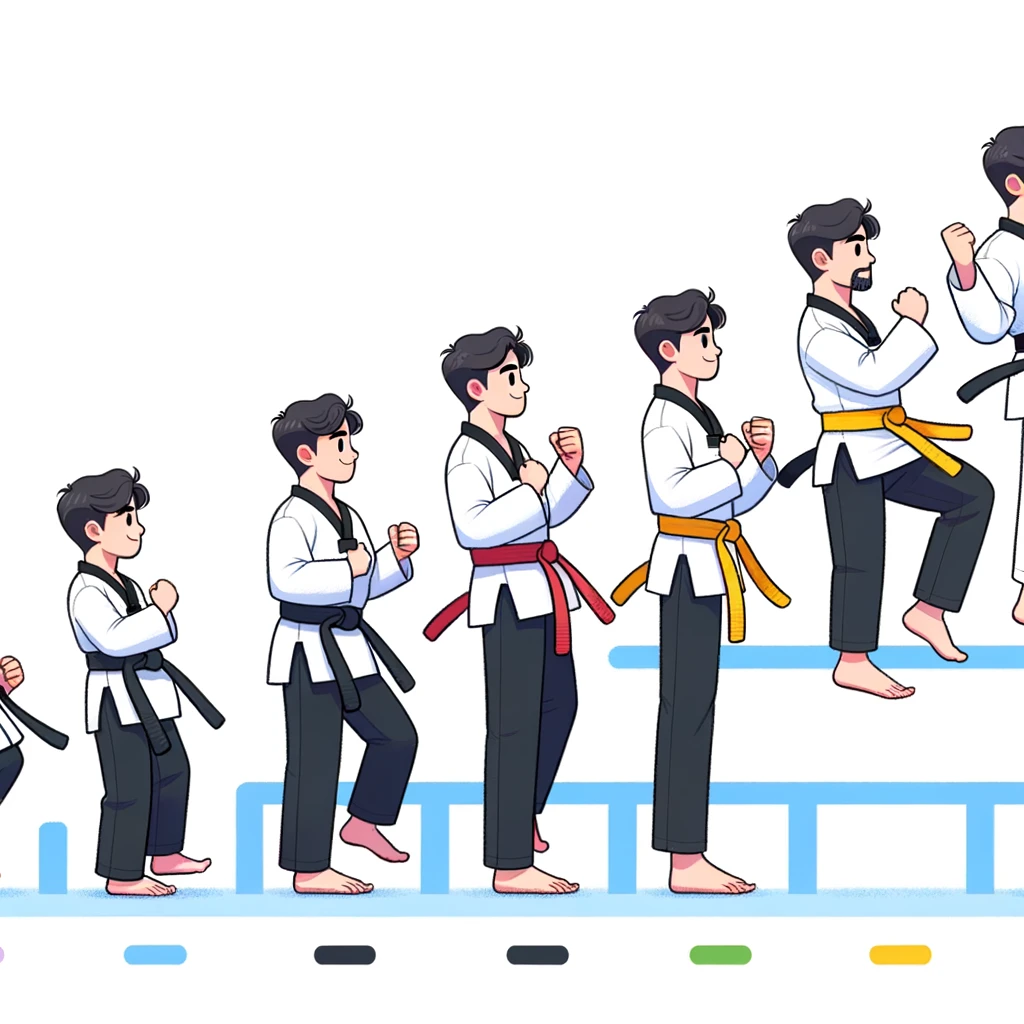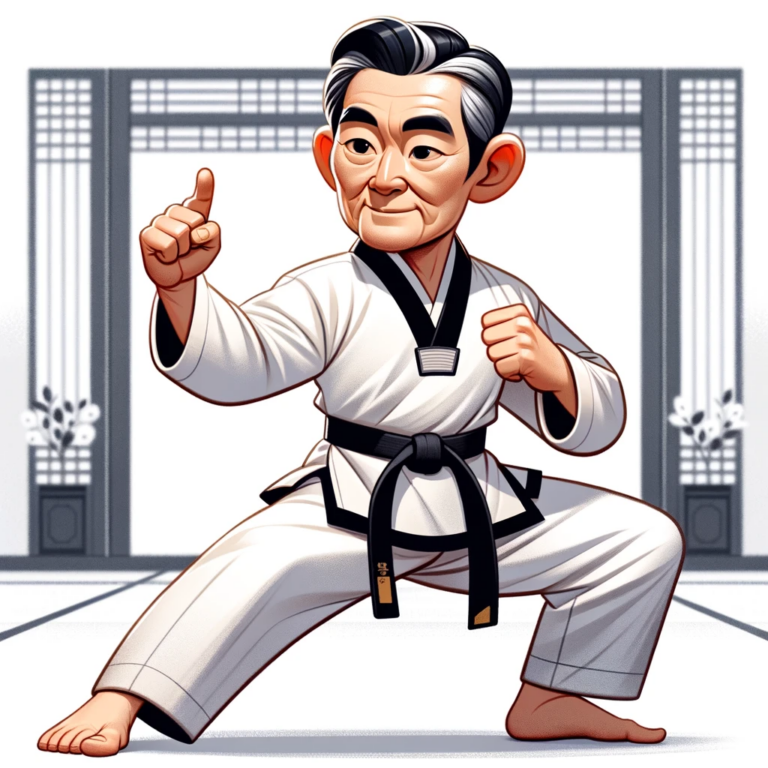The Journey Towards Martial Excellence
Achieving martial excellence is a lifelong journey that requires commitment, perseverance, and a deep understanding of the chosen discipline but How long does it take to get a black belt in Taekwondo?
Whether it is Taekwondo, karate, or judo, the path towards mastery is paved with countless hours of practice, self-discipline, and personal growth.
One critical component of embarking on this journey is setting challenging and attainable goals. By having clear and measurable objectives, practitioners can stay motivated and focused on their progress. Whether mastering a specific form, earning a higher belt rank, or competing in tournaments, these goals provide a sense of direction and purpose in pursuing martial excellence.
Understanding the belt system is another crucial aspect of the journey towards martial excellence. In Taekwondo, practitioners progress through coloured belts before achieving the coveted black belt. Each belt represents a different level of skill and knowledge, and the transition from one belt to the next requires the individual to demonstrate mastery and understanding of various techniques, forms, and sparring drills. By embracing the belt system, martial artists can track their progress, set milestones, and continually challenge themselves to reach new proficiency levels.
Setting Goals in Taekwondo: The Path to Black Belt
Setting goals is an essential part of obtaining a black belt in Taekwondo. The process of setting goals helps students to stay focused, motivated, and committed to their training. Each belt level in Taekwondo represents a specific set of skills and knowledge that must be acquired before progressing to the next rank. Therefore, students must set realistic and achievable goals to ensure steady and continuous progress on their path to the coveted black belt.
When setting goals in Taekwondo, it is essential to consider both short-term and long-term objectives. Short-term goals may include mastering specific techniques, improving physical fitness, or consistently attending training sessions. These smaller milestones serve as stepping stones towards the ultimate goal of earning a black belt. On the other hand, long-term goals should reflect a student’s aspiration to reach higher levels of skill, knowledge, and leadership within the Taekwondo community. Students can track their progress and stay motivated by setting clear and measurable objectives.
Understanding the Belt System in Taekwondo
The belt system in Taekwondo is an integral part of the martial arts’s culture and tradition. It serves as a visual representation of a practitioner’s progress and skill level within the discipline. From the beginner white belt to the highly skilled black belt, each belt colour signifies a certain level of proficiency and understanding of the techniques and principles of Taekwondo.
The progression through the belt system is not solely based on time or age but on mastering fundamental techniques and demonstrating mental and physical discipline. As practitioners advance to each new belt level, they are expected to understand better the art’s core values, such as respect, perseverance, and self-control. The belt system provides a clear structure for students to set goals and work towards achieving higher ranks, motivating them to grow and improve their skills continuously.
The Importance of Discipline and Dedication in Training
In pursuing martial excellence, discipline and dedication play a vital role in training. Like any other martial art, Taekwondo demands high commitment and perseverance. In this context, discipline refers to the ability to adhere to strict training regimens, follow instructions, and maintain focus throughout the journey.
Taekwondo requires dedication and entails giving the practice your utmost effort and time. It involves committing to consistent training sessions, honing physical and mental skills, and continually striving for improvement. Dedication also means being determined to overcome obstacles and challenges that may arise during the training process. By embracing discipline and commitment, taekwondo practitioners unlock their full potential and reap the benefits of this ancient martial art.
Breaking Down the Different Ranks and Requirements in Taekwondo
In the martial art of Taekwondo, practitioners progress through a series of ranks, each marked by a different colour belt. This ranking system provides a visual representation of a practitioner’s progress and a guide for the skills and knowledge they should acquire at each stage of their journey.
Students start with a white belt at the beginner level, symbolizing purity and a blank slate. They gradually earn higher ranks as they demonstrate essential techniques and show commitment to their training. The progression typically includes coloured belts such as yellow, orange, blue, green, and brown, each representing deeper understanding and skill development. Finally, after years of dedicated training and mastering advanced techniques, practitioners reach the pinnacle of their journey: the black belt. This coveted rank signifies the highest level of competence, discipline, and mastery of TaekwoTaekwondoite Belt: The starting point for all beginners in TaekwoTaekwondoolizing purity and a blank slate.
• Yellow Belt: Demonstrating basic techniques and commitment to training.
• Green Belt: Progressing further with increased understanding and skill development.
• Blue Belt: Advancing to more profound knowledge and proficiency in TaekwoTaekwondoeen Belt: Continue to build upon previous skills and demonstrate advanced techniques.
• Red Belt: Mastering complex movements, showing discipline, and preparing for the final stage.
• Black Belt: The ultimate goal in TaekwoTaekwondoesenting is the highest level of competence, discipline, and mastery.
What is Taekwondo?
Taekwondo is a Korean martial art focusing on self-defence, physical fitness, and mental discipline.
How long does it take to earn a black belt in Taekwondo?
The time it takes to earn a black belt in Taekwondo depends on the individual’s dedication, training frequency, and natural ability. On average, it can take several years of consistent practice to reach this level of proficiency.
What are the different ranks in Taekwondo?
Taekwondo uses a belt system to signify different ranks. The order of ranks is typically white, yellow, green, blue, red, and black.
What are the requirements for each rank in Taekwondo?
The specific requirements for each rank can vary between different Taekwondo schools or organizations. Generally, requirements include mastery of specific techniques, forms (patterns), sparring skills, self-defence techniques, and knowledge of Taekwondo philosophy.
Can anyone practice Taekwondo regardless of age or fitness level?
Yes, Taekwondo is practised by people of all ages and fitness levels. However, it is essential to consult with a qualified instructor to determine the appropriate level of training and intensity based on individual capabilities.
How important is discipline and dedication in Taekwondo?
Practice and commitment are essential in Taekwondo to help develop focus, perseverance, and self-control. Without these qualities, progress and improvement in Taekwondo are challenging.
Can Taekwondo improve physical fitness?
Yes, practising Taekwondo significantly improves physical fitness. It enhances strength, flexibility, endurance, balance, and coordination. Regular training sessions, including conditioning exercises and intense workouts, enhance overall wellness.
Is Taekwo Taekwondo about self-defence?
While self-defence is essential to Taekwo, Taekwondo also focuses on personal development, mental discipline, and character building. It promotes self-confidence, self-discipline, respect, and the ability to make correct moral choices.
Is Taekwondo a competitive sport?
Yes, Taekwondo is an Olympic sport and has a competitive aspect. Competitions are held at various levels, from local to international, and involve sparring, forms, and breaking techniques.
Is complete contact sparring a part of Taekwondo training?
Full contact sparring is a component of advanced Taekwondo training. It allows practitioners to apply their techniques with controlled contact, helping to develop timing, accuracy, and defensive skills. Safety measures and protective gear are used during sparring to minimize the risk of injury.







